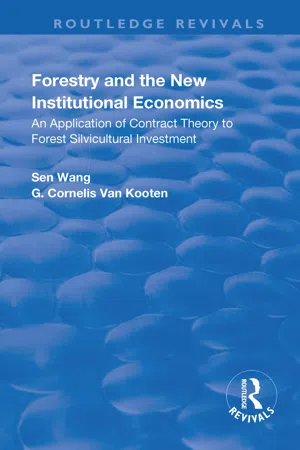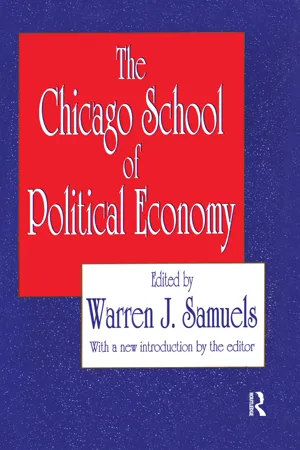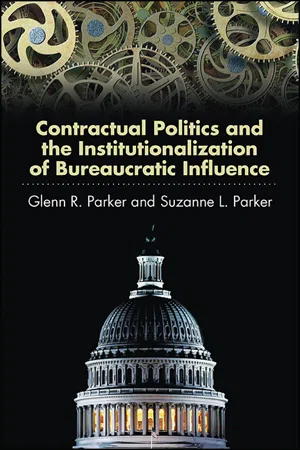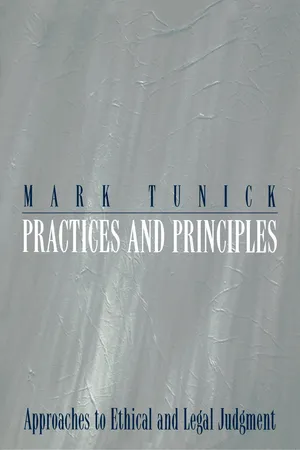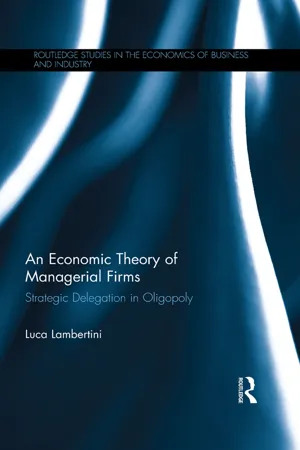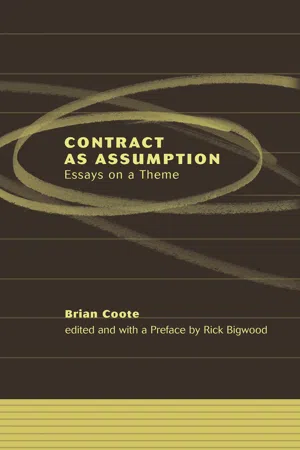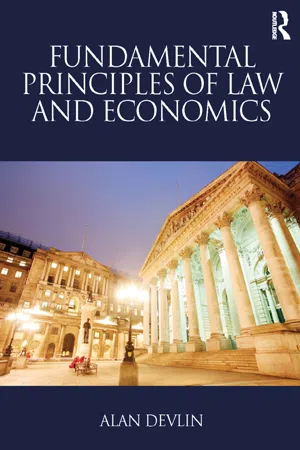Economics
Contract Theory
Contract theory in economics examines the design and implementation of agreements between parties to achieve mutually beneficial outcomes. It explores how contracts can align incentives, mitigate risks, and facilitate cooperation in various settings, such as employment relationships, procurement, and public-private partnerships. The theory considers issues like information asymmetry, moral hazard, and adverse selection to inform optimal contract design.
Written by Perlego with AI-assistance
Related key terms
Related key terms
1 of 4
Related key terms
1 of 3
11 Key excerpts on "Contract Theory"
- eBook - ePub
- Donald Rutherford(Author)
- 2007(Publication Date)
- Routledge(Publisher)
Veblen in his analysis of the leisure class noted the phenomenon of ‘conspicuous consumption’, which is undertaken for the purpose of flaunting one’s status in society. Hirsch devised the term ‘positional good’ to describe something rare and exclusive which cannot be reproduced in large amounts. Its appeal is its non-availability to more than a few. Various forms of education, artistic performances and properties have this character.See also: KeynesianismFurther reading: Hirsch 1976; Lancaster 1971Passage contains an image
Contract Theory
An extension of the analysis of exchange and production.Aristotle in the Nichomachean Ethics, book V, stated that it is dissimilar things which are exchanged so that some rules are necessary to bring about fairness. Francis Hutcheson, who taught Adam Smith, in his System of Moral Philosophy (1755), book II, chapter 9, examined the obligations which arise from contracting. He argued that commerce would be obstructed if the contracting parties could repudiate imprudent contracts. The contract should be naturally possible and the parties should make every attempt to discover the factors which affect the value of the goods and restore any excess which has been given. In the 1880s Edgeworth used contract curves to describe bilateral exchanges in the absence of uncertainty and asymmetric information.Contracting can be bilateral or multilateral. Employment contracts are often bilateral, even under collective bargaining as two bargaining bodies negotiate. Multilateral contracts are common in insurance, where risks are widely shared, and in industries such as construction, where many different contractors aim to produce a complex building; also multilateral contracts occur in sharecropping, partnerships and franchise operations. The presence of several contractors raises questions of collusion and competition, both of which can affect the optimality of the contract. In the formation of contracts the parties are faced with problems of hidden or misleading information and uncertainty. There can be repeated bilateral contracting when circumstances surrounding the contract are short-term, for example, demand is volatile or output is variable, so that a chain of contracts reduces uncertainty. Contracts can refer to a present sale or to a future transaction. Also the contract might be an option to buy rather than an actual purchase. An efficient contract will produce stable prices and output. - eBook - ePub
Forestry and the New Institutional Economics
An Application of Contract Theory to Forest Silvicultural Investment
- Sen Wang, G. Cornelis van Kooten(Authors)
- 2018(Publication Date)
- Routledge(Publisher)
Unlike the risk-incentive approach, contracts can also be examined using a transaction cost approach. This approach still uses the principal-agent framework, but focus has shifted to things like job attributes and agent characteristics. The objective of the principal is to choose contractual forms ranging from direct hiring and contracting out, and, once a contractual form is picked, efforts are made to synchronize the vectors of job attributes with agent characteristics. The purpose is to economize on transaction costs. In this chapter, we examine the theory of contracts from the perspective of transaction costs. First, we develop a theory of contracts. Then we discuss the problem of information given the crucial role that information plays in economic decisions. Various issues concerning transaction costs are explicated. Finally, we discuss the application of Contract Theory to the issue of forest renewal.4.1 Theory of Contracts
Beginning with the production function, it is customarily posited that production in the primary sectors entails the use of essential inputs including land, labor and capital:Q = f(.K , L , H) ( 4.1 )Q is output, f is a production function that is linearly homogeneous, and increasing and concave in its arguments, K refers to capital inputs (e.g., machinery, tools, seeds, or forest seedlings in the case of tree growing), L is labor, and H is land.Following routine specifications (see Lazear 1989; Allen and Lueck 1993; Eswaran and Kotwal 1985; Braverman and Stiglitz 1986), the theory of contracts may be derived from the standard production function (4.1) . First, the economic world is assumed to be characterized by a competitive environment in which two individuals form a contractual relationship. These two individuals are known as the principal and the agent. The contractual relationship arises because the principal chooses to hire the agent to do the work in producing commodity Q . As a result of negotiation, an incentive contract is reached between the two parties, whereby they agree to share the outcome of the contract. As the principal does not do the work personally, she has a utility function, V , which is a function of her share of the product only. It is assumed that V - eBook - ePub
Islamic Microeconomics
An Introduction
- Lukman Hanif Arbi, M. Ishaq Bhatti(Authors)
- 2023(Publication Date)
- Routledge(Publisher)
Economics of the law has been a very vast and productive field in conventional economics surpassing the scope of this book, for example, in Shavell (2004) and Posner (2014). In order to keep with the main goal of this book, we must therefore limit ourselves to the evaluation of IFS s using Contract Theory, which is the sub-field of economics concerning the subtler aspects of designing contracts as instruments of regulation. Another benefit to this approach is to have a better appreciation for why IFC s are the way they are. We begin this chapter with a discussion regarding the need for regulation, which generally comes from information asymmetry. We then discuss the applicability of Contract Theory to IEF as well as a technical aspect concerning uncertainty and information asymmetry in an Islamic context. Anticipating the dislike of the conventional approach to uncertainty, we provide a literature review of more sophisticated approaches to uncertainty including prospect theory. Next, we discuss classic solutions to the two main problems associated with information asymmetry, namely adverse selection and moral hazard before demonstrating how a Contract Theory model works. We then review the literature on how Contract Theory has been applied to finance. We end with a summary of this chapter. 4.2 Information Asymmetry, Regulation, and Contract Theory Early classical economists did not pay much attention to the role of contracts in economics, which seemed to be straightforward during that time. The basic general equilibrium models such as the one explained in Jehle & Reny (2010) assume the existence of a (perfect) market and therefore the market institution, including the regulation of commercial contracts. One reason in favor of this abstraction is the existence of two assumptions behind the perfectly competitive market: the first being the perfect information assumption and the second being the assumption that no market agent has significant market power - eBook - ePub
- Nadia Mizner, Warren Samuels(Authors)
- 2021(Publication Date)
- Routledge(Publisher)
18 the distinction often is imposed for analytical convenience and then by careless usage elevated to a self-evident truth.Economics and Long-Run Contractual Relations
The paradigmatic contract of neoclassical economics and of legal analysis is a discrete transaction19 in which no duties exist between the parties prior to the contract formation and in which the duties of the parties are determined at the formation stage. Prior to their contract, Smith has no duty to Brown; at the time they enter into their agreement, in a single joint exercise of their free choice, they determine their respective duties to each other for the duration of the agreement; completion of the promised performance terminates that party’s obligations. In Ian Macneil’s words, “sharp in by clear agreement; sharp out by clear performance.”20 While this quite accurately portrays many transactions, there is a large set of contracts for which this is a grotesque caricature. Relations which are to take place over a long period of time and in which the parties will have to deal with each other regularly over a wide range of issues (many of them unknown in advance) often are forced into this discrete transactional mold, both in legal and economic analysis.The law of contracts to some extent has been forced to come to grips with the complex issues raised by such relationships by the poor fit into the transactional mold of relational fact patterns that are brought before the court. On the other hand, the elegance (and, to be sure, practical merits in many contexts) of analytical models based on choice has led economists to suppress the relational aspects of contracts. Thus, while legal scholars are at least making slow progress toward accommodating long-run complex relations in a broadened theory of contract,21 economists have, with rare exceptions, not faced up to (or even perceived) the problems.22 Here, concern will be focused on the economic implications.23 - eBook - ePub
Economic Analysis of Contract Law
Incomplete Contracts and Asymmetric Information
- Sugata Bag(Author)
- 2018(Publication Date)
- Palgrave Macmillan(Publisher)
© The Author(s) 2018 Sugata Bag Economic Analysis of Contract Law https://doi.org/10.1007/978-3-319-65268-9_2Begin Abstract2. Basics of Economic Theory of Contract
End AbstractSugata Bag1(1) Department of Economics, Delhi School of Economics, Delhi, India2.1 Introduction
The organisation of market and the institutions in many ways govern economic relationships and contracts. And any discussion of contract law, without the understanding of the basic mechanism of contracts would be futile. Therefore, in this chapter, we revisit the basics of economic theory of contracts to focus on models that take into account the full complexity of strategic interactions related to trade between two privately informed agents in well defined institutional settings.We encompass various aspects of contracting through the simple design of a multi-task model of contracts. The model will allow us to sum up the constraints imposed by the prevailing institutional setting through a contract. The present model will set the basic analytical framework for the rest of the book. The lessons drawn from the analysis here will be integrated into the economic analysis of contract laws carried out in later chapters.In the course of this chapter we shall explore: the need for contracts under various market modes; how market institutions and incomplete information play a role; what kinds of contract parties enter into under different market and informational set-ups; how these contracts help parties to reap the gains from trade; and what kinds of incentive are being provided under different contracting scenarios.The analysis in this chapter will highlight the canonical hold-up problem, which is a central issue in a bilateral trading set-up. The main focus throughout the analysis will based on situations where the asymmetries of information develop subsequent to initiating a formal trading relation (through non-verifiability). We shall also analyse the agency problems with renegotiation, asking when it is possible to give an agent the efficient incentive to work on an asset or project that a principal will directly use or sell in the up-market. The courts can only verify (1) payments between the parties, (2) the possession (ownership) of the asset or project, and (3) the contractually binding statements such as offer, acceptance or the exercise of an option. Throughout this chapter, our maintained assumption is that trade is always feasible and profitable despite uncertainty . So the role of contract laws can be limited to the settlement of disputes or - Carl J. Circo(Author)
- 2019(Publication Date)
- Routledge(Publisher)
14 Although that rationale does not seem evident in the construction contract cases on liquidated damages, the discussion later in this chapter acknowledges that industry cases occasionally do reflect the influence of economic analysis on certain other issues. I do not, however, see evidence that the central themes of economic theory have explicitly accounted for distinct developments in the industry cases. The law and economics literature seems most relevant to construction industry contracts where it overlaps with relational Contract Theory, to which I now turn.Relational Contract Theory stems from the considerable work of Professor Ian Macneil, which in turn reflects the influence of Professor Stewart Macauley’s empirical studies of contract.15 Classical, neoclassical, and economic theory, all consider contractual arrangements essentially as discrete transactions defined by the fixed terms the parties negotiate and governed by the controlling principles of contract law. By contrast, “relational theories assign a central role to the overall context that generates the dynamic and interdependent relationship between the parties.”16 Relational theory “focuses much more on customs, usage, and behavioral considerations and much less on legal rules and principles, consent, expressed or presumed intent, and the language the parties used to establish the arrangement at its inception.”17 The relational concept of contract favors highly flexible legal principles designed to preserve exchange relationships in the face of changing circumstances. It promotes the benefits of incomplete contracts and, in some iterations, is especially open to processes for filling in the gaps those contracts routinely leave open.13 Gregory Klass, The Rules of the Game and the Morality of Efficient Breach, 29 Yale J.L. & Human . 71, 81 (2017).14 See W. Alexander Moseley, How Can the Construction Industry Better Manage Consequential Damages for Delay? And Will the Courts Cooperate?, 3 J. Am. C. Construction Law. 3 (2009).15 SeeIan Macneil, The New Social Contract: An Inquiry into Modern Contract Relations (1980); Stewart Macaulay, Relational Contracts Floating on a Sea of Custom? Thoughts About the Ideas of Ian Macneil and Lisa Bernstein, 94 Nw . U. L. REV. 775 (2000); Ian R. Macneil, Relational Contract Theory: Challenges and Queries- Glenn R. Parker, Suzanne L. Parker(Authors)
- 2018(Publication Date)
- SUNY Press(Publisher)
4 A Theory of Political ContractsIn the previous chapter we described how various concepts and arguments drawn from the study of transactions-cost economics, bureaucratic control, and agency design fit into our characterization of political contracts and the centrality of advisory committees to these arrangements. Here, we weave these arguments together with the earlier discussion of the political utility of advisory committees (chapter 2 ) to construct a theory of political contracting. The theory elaborates on the themes introduced in chapter 1 , and offers a unique twist to the study of interest group politics. In this chapter, we revisit arguments from earlier chapters and formalize them, figuratively and literally, into a contractual theory of interest group politics. Specifically, we show how long-term agreements between parties and special interests, despite being tacit and unenforceable, are sustained under conditions inherent in transactions of this nature.Although our theory addresses the widely recognized interrelationship between agencies, parties, legislatures, and interest groups, our account differs profoundly from conventional models of this subgovernmental relationship (see, for example, Lowi 1969; Stigler 1971; Fiorina 1989). In sharp contrast to these theories, we draw attention to issues commonly ignored in traditional treatments of interest group politics: the friction between bureaucrats and special interests; the efficiency of contracts as an arrangement for organizing political exchange; the significance of in-house bureaucratic decisions to special interests; and the specialization of groups to a single party.- eBook - ePub
Practices and Principles
Approaches to Ethical and Legal Judgment
- Mark Tunick(Author)
- 2021(Publication Date)
- Princeton University Press(Publisher)
Contract law differs from the practice of promising because it involves legal enforcement, hence it brings into play institutional considerations absent when we think about where our moral obligation lies. Yet contract law has a point apart from the augmentation of social wealth, and its point is connected with the practice of promising. Economic efficiency is an important standard for deciding which promises should be legally enforced and what remedy for breach is appropriate. It provides a reason that we lack when we merely defer to conventions and norms. It can fill in the gaps left by other principles that theorists find in the law of contract, such as the promise principle or the principle of reliance. But if efficiency theory becomes totalized and abstracted from the practice, it leads to odd explanations, such as Posner’s efficiency argument for nonenforcement of coerced promises.The moral idea that one ought to keep one’s promise may be the historical basis for the legal institution of contracts. The law of contract did not simply emerge by design in accordance with economic theories; rather, it evolved from earlier practices and custom. Anglo-American contract law, for example, has its roots partly in the canon law of the medieval English Church and the fidei laesio. 155 Still, contract law’s genealogy needn’t dictate blind deference to custom. Judges and lawmakers should appeal to principles in deciding how contract law should continue to evolve or, when the law is ambiguous, how it should be interpreted in a particular case. In doing so there is an important role for the principle of economic efficiency. The fact that the moral ideal that one ought to keep one’s promises is expressed in institutions means that institutional considerations, including considerations of economic efficiency, are not inappropriate to take into account, at least in deciding the issue of which promises should be enforced by courts.156 - eBook - ePub
An Economic Theory of Managerial Firms
Strategic Delegation in Oligopoly
- Luca Lambertini(Author)
- 2017(Publication Date)
- Routledge(Publisher)
The prevailing view about the nature of the firms is that they are a nexus of contracts rather than simply a container of technologies (see, once again, Jensen and Meckling, 1976). Consequently, the firm appears to be more easily understood in terms of the contractual and informational constraints it faces, rather then those of a technological nature described in neoclassical microeconomics.This chapter offers a reconstruction of the debate about the nature of the firm as a set of contracts, from its early days when the matter was understanding the reasons for internalizing transactions into firms replacing portions of markets to its latest developments combining agency theory with oligopolistic interaction. As will become clear in the remainder, the evolution of this debate has a common flavour but is not linear, as the theory of the growth of the firm – initiated in the late 1950s and then abruptly abandoned twenty years later – illustrates.1.1 Of firms and marketsAlthough a sense of the diversity, alterity and antagonism between firms and markets already existed (see, e.g., Berle and Means, 1932), the explicit departure from a theory of the firm based upon the efficient use of technology in competitive markets must be credited to Ronald Coase (1937). In Aghion et al. (2011, p. 181) words:Ronald Coase raised a question that may at first appear naive but in fact turned out to be fundamental: if the market is an efficient method of resource allocation, then why do so many transactions take place within firms? Coase developed verbal arguments for the existence of firms, in particular emphasizing haggling problems in decentralized market transactions, which he thought authority within firms could partly overcome. In other words, firms exist because there are costs to using the price mechanism: prices must become known, bargains must be made, contracts must be written. In his famous essay, Coase (1937) quoted the description of D.H. Robertson (1928, p. 85) that firms are ‘islands of conscious power in oceans of unconsciousness like lumps of butter coagulating in buttermilk.’ - eBook - ePub
Contract as Assumption
Essays on a Theme
- Brian Coote, Rick Bigwood(Authors)
- 2010(Publication Date)
- Hart Publishing(Publisher)
If some traditional definitions of contract have had their disadvantages, the position is rather worse with traditional theories of contract. All of them can be shown to have drawbacks of one sort of another.The Purposes of Contract Theories
In evaluating contract theories it has to be appreciated that their purposes may vary.48 Of some, the purpose may be to justify the legal recognition and enforcement of contracts. Of others, it may be to explain the role of contracts in society. A third purpose may be to provide a basis for predicting in a given situation whether a contract will arise or what the law of contract will be.An illustration of this third type of purpose can be found in the search for a ‘general’ theory of contract. Before more modern times, what would now be recognised as contracts seem always to have been distinguished from other dealings by the use of special forms or ceremonies.49 These could include hand clasps,50 the taking of oaths or the pledging of faith, the use of writing or the recital of a formula,51 the mingling of blood,52 the exchange of tokens or weds,53 or the exchange of hostages.54 Later commentators saw the forms and ceremonies as being in themselves the source of legal contractual obligation.55 It was assumed that the path to progress would lead away from form towards deriving obligations from the promise or agreement itself.56 By the early seventeenth century, Grotius felt able to say that all contracts which proceeded from reasonable causes, whatever be the form of words used, gave a right of action.57 The sort of general theory which passed into common currency on the Continent was that wherever there was a seriously intended agreement there was a contract, provided that the object the parties had in view was not illegal, immoral or contrary to public policy.58 A comparable common law version suggested by Professor Karl Llewellyn was that a bargain is enforceable unless reason appears to the contrary.59General theories of this kind could say little, directly, about the justifications for enforcing contracts or about the place of contracts in society. They could, however, serve to predict the presence of a contract though, in practice, the extent to which they might do so could vary from one system to another. For present purposes, their importance lies in their tendency to support a search for theories which would base contract on general concepts like agreement, promise, will or bargain, rather than on the fulfillment of technical requirements. - eBook - ePub
- Alan Devlin(Author)
- 2014(Publication Date)
- Routledge(Publisher)
For example, consider whether a state should implement a “three-strikes law”. California is a jurisdiction that imposes mandatory life sentences on criminals whom it convicts of a third felony. Such laws can involve grave disparities between the wrong (it may be non-violent) and the severity of the ensuing punishment. This gulf between crime and punishment offends many people’s sense of justice, which requires proportionality between the offending act and corresponding penalty. Yet, a prediction that the “three-strikes” law would reduce crime surely weighs on whether to enact such legislation. It remains true, of course, that a legislature may properly refuse to pass draconian laws, but its decision is more informed if it has all relevant information, including that supplied by economic analysis.The point, in short, is that efficiency need not be controversial, especially when one realises that efficiency is but a component of the larger concept of justice. Law and economics is a powerful tool of policy analysis, but it is by no means the exclusive means by which to understand legal problems.C. The Ethics of Markets 1. Introduction: contracts, market transactions, and efficiencyVoluntary transactions play a celebrated role within law and economics. To recognise the legitimacy of private contract is to pay homage to individual liberty. From a neoclassical perspective, voluntary agreements generate benefits by mutually satisfying contracting parties’ preferences, at least if one respects adults as competent determinants of their own well-being. Such satiation renders contracting parties “better off”, at least if one accepts the premise that fulfilling an individual’s wish without violating that of another person advances welfare.Binding arrangements can still benefit informed, competent parties even if some promisors ultimately regret their contractual obligations. People contract because doing so yields net expected benefits ex ante. Most agreements allocate risk, promoting each contracting party’s welfare ex ante. Nevertheless, the person for whom the embraced risk comes to pass may be worse off ex post. While relieving him of contractual responsibility would benefit that party in the short term, doing so would undo the long-term value of contracts for all.By advancing individual well being at the micro level, contracts generate macro-level benefits. Private deals reallocate scarce resources from lower- to higher-value uses, thus efficiently distributing scarce resources throughout the economy. No government can hope unilaterally to perform a comparable function. Stymied by information constraints, buffeted by interest groups, handicapped by regulatory lag, and inhibited by inadequate resources, the government cannot effectively dictate and continually monitor the optimal path of economic activity. Market-based economies, in contrast, harness private information to coordinate the efficient utilisation of scarce resources. Individual contracting, which lies at the heart of this process, creates a decentralised price mechanism that synchronises the extrication, transformation, and ultimate consumption of limited resources. The failure of centrally managed economies, such as that of the former Soviet Union, to achieve sustained levels of economic growth comparable to capitalist countries evidences this fact, as does China’s extraordinary growth since its hybrid adoption of market mechanisms.
Index pages curate the most relevant extracts from our library of academic textbooks. They’ve been created using an in-house natural language model (NLM), each adding context and meaning to key research topics.
Explore more topic indexes
Explore more topic indexes
1 of 6
Explore more topic indexes
1 of 4

